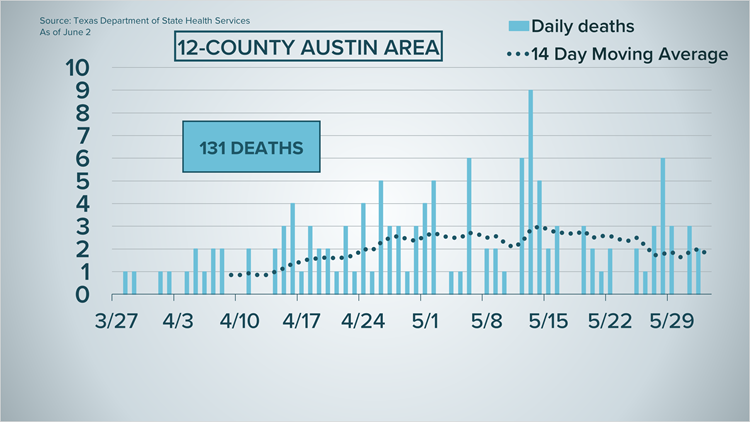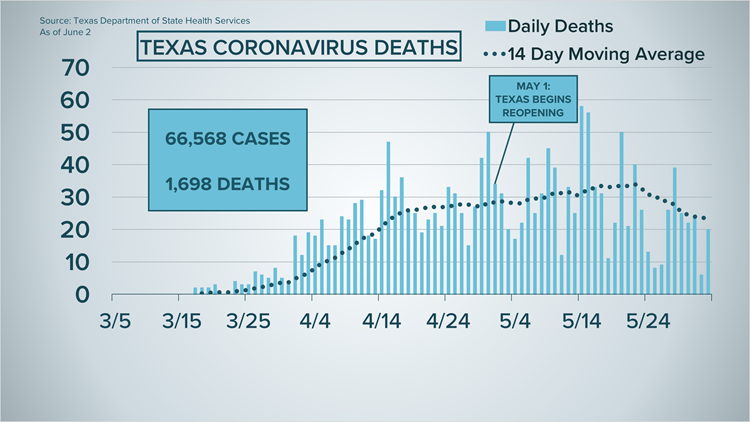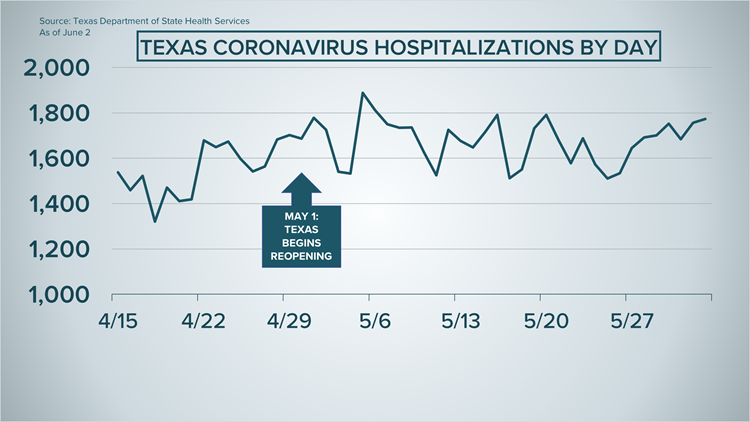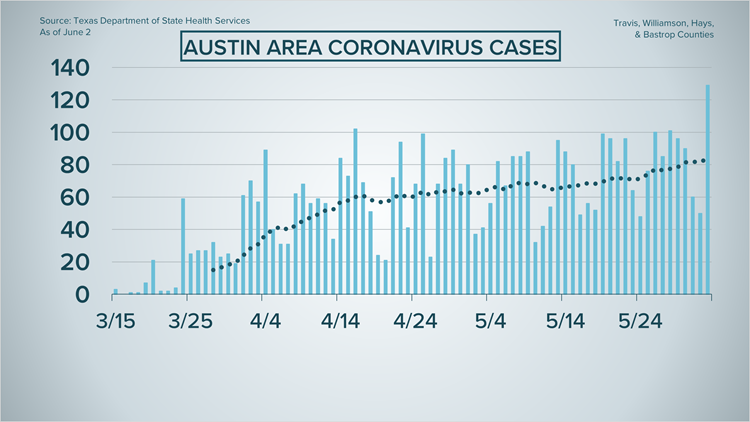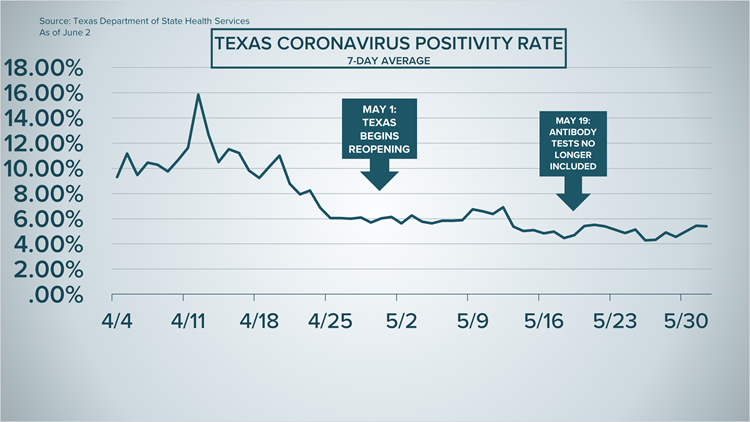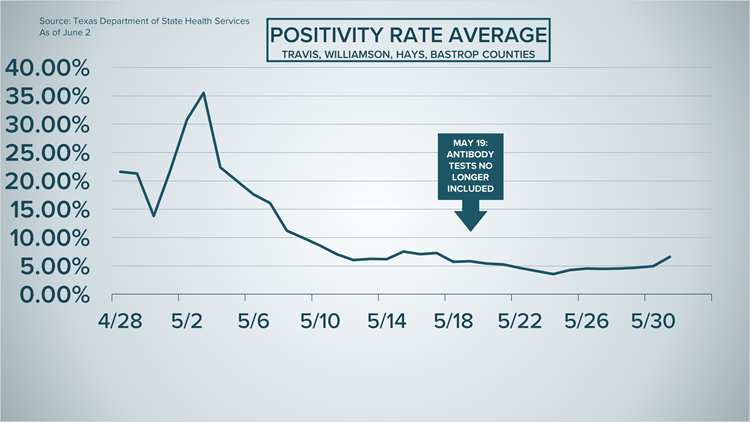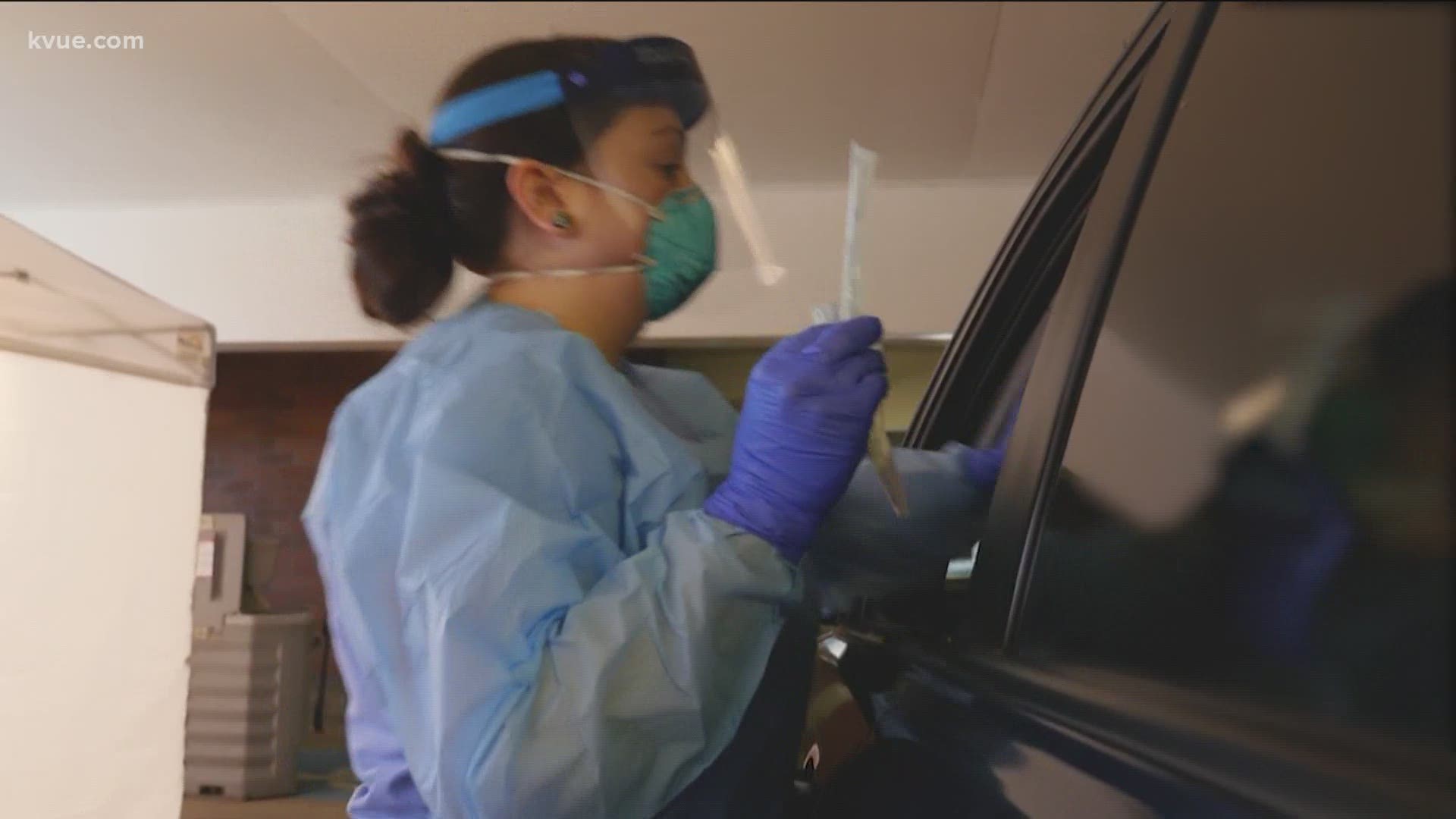AUSTIN, Texas — Editor's note: This blog is no longer active. For the latest updates, check out our new live blog.
KVUE is keeping you updated with the latest coronavirus, also known as COVID-19, news in the Austin area.
Scroll down for the top headlines and latest updates in KVUE's June 2 live blog.
COVID-19 numbers:
- Texas: More than 64,000 cases have been reported in the state, and more than 1,600 people in Texas have died, according to the Texas Department of State Health Services. The department estimates more than 43,000 people have recovered from the virus.
- Central Texas counties:
- Travis County: More than 3,400 cases have been reported and at least 93 people have died. At least 1,296 people have recovered from the virus.
- Williamson County: More than 600 cases have been reported and at least 25 people have died. More than 399 people have recovered from the virus.
- Hays County: There have been at least 350 cases reported in the county and at least five people have died. Around 196 people have recovered from the virus.
GRAPHS: Texas coronavirus data June 2
Top headlines:
- LIST: Confirmed Central Texas coronavirus cases by county
- New survey says about 1/3 of people have gone out to eat, drink in past two weeks
- Mayor Adler discusses how Austin is helping Latino community impacted by COVID-19
- Austin/Travis County remain in Stage 3 of COVID-19 risk-based guidelines, health leaders say
Updates:
10 p.m. – Some medical professionals are worried that the protests happening nationwide could lead to an increase in COVID-19 cases. Many in the health care community understand why the protests are happening but want those attending to be cautious.
"How we identify the surge is how many who actually seek care because – and we're doing some testing but not nearly to the level to know, you know, to be able to forecast well how many are infected," said Cindy Zolnierek, RN, the CEO of the Texas Nurses Association. "So, you know, I really think we will see an increase in cases but to what extent ... I don't know."
7 p.m. – The Burnet City Council has approved a program to provide utility assistance to Burnet businesses that have been severely financially impacted by the COVID‐19 pandemic.
The City of Burnet Commercial Customer Public Utility Payment Assistance Program aims to help promote the retention of local businesses by providing City utility customers with small and/or large commercial electric utility service accounts with grants in the form of a 50% credit on their bill for the month of May, up to a maximum of $7,500.
Click here for more information.
6:30 p.m. – Travis County on Tuesday confirmed 73 new cases of COVID-19, bringing the total to 3,433. At least 1,296 people have recovered from the virus, while the number of deaths in the county remains at 93.
4:45 p.m. – Hays County announces 18 new cases along with nine new recoveries. Two more people were admitted to the hospital.
Total confirmed cases are now 371, while recoveries are now at 205.
3:40 p.m. – According to UT Austin, the country's first peer-reviewed study of a COVID-19 treatment that transfuses plasma from recovered patients to critically ill patients shows 19 out of 25 patients improving, with 11 discharged from the hospital. With no adverse side effects caused by the transfusions, the study concluded that convalescent plasma therapy is a safe treatment option for severe COVID-19 cases.
The study also found that patient outcomes after the therapy were similar to published results of patients treated on a compassionate-use basis with the drug remdesivir. Any observed complications were also found to be consistent with reported COVID-19 disease progression and not as a result of the transfusions.
You can read about the study's findings here.
RELATED: Texas DSHS distributing antiviral drugs to hospitals across Austin area for COVID-19 treatment
3:30 p.m. – UT Austin plans to offer most classes in person in the fall. According to The Daily Texan, the school will move its 400 biggest classes online, but the other 1,100 will be offered in a traditional format, though the school hasn't said how those will be managed. UT previously announced on-campus classes will run from August to Thanksgiving then continue remotely to control the spread of COVID-19.
11:34 a.m. – Austin Public Health announces plans to launch mobile and targeted testing sites in key locations around Travis County to help address the disproportionate impact of COVID-19 on vulnerable populations.
The targeted sites will help the work done by community partners like CommUnity Care to increase testing availability to people who have not been able to receive testing through previously-established programs. Their goal is to fill the gaps in the community through targeted testing, mobile testing, cluster testing, home testing and static testing sites.
The two key vulnerable groups identified by APH are communities of color and nursing home residents.
According to APH, about 30% of nursing home residents who contract COVID-19 end up in the hospital, compared to about 15% in the general population. And the fatality rate among this population is 22%, compared to 1.7% for the general population.
"COVID-19 has a devastating impact on our nursing homes and in our population over the age of 65," Dr. Mark Escott, Interim Health Authority for Austin-Travis County, said. "This data conclusively demonstrates the critical importance of an overhaul of infection control procedures and nursing home design to mitigate the impact of COVID-19 as well as other communicable diseases."
APH data shows that COVID-19 hospitalization rates in March through April were 12% for white non-Hispanic individuals, 17% for LatinX individuals, and 18% for African Americans. The fatality rate was 1.9% for white non-Hispanic individuals, 1.6% for LatinX, and 5.4% for African-Americans.
“These statistics are concerning and unfortunately, not unexpected given the history of disparities in access to healthcare and in the social determinants of health impacting communities of color. While this data is preliminary and the actual magnitude of the impact on these communities is not yet certain, we will not sit idly by watching and waiting until we reach scientific certainty before taking action,” Escott said.
APH said that aside from coronavirus, communities of color experience higher incidences of chronic conditions, such as hypertension, diabetes and heart disease. Health officials also reported that they disproportionately work in low-paying or hourly-wage jobs, which leaves them unable to provide care or interrupt work, and are more likely to be uninsured, live in medically underserved areas, and live in ZIP codes with lower life expectancy.
“People of color are over-represented in every characteristic that puts you at risk for complications from COVID-19,” Brion Oaks, the City’s chief equity officer, said. “They are also over-represented in essential work and employed in positions that do not allow working from home. We may be in the same storm, but we are not in the same boat. We must focus on supporting our communities of color and other vulnerable populations as we work to respond to this crisis.”
Other factors such as immigration status, multigenerational housing situations, concern about losing wages if quarantine is required, limited transportation options, or employment where telework is not possible, can also make a person more vulnerable to the virus.
RELATED: Austin councilmembers urge Gov. Abbott to address high COVID-19 hospitalization rate among Latinos
“As a community, we’ve done a relatively good job keeping our total number of COVID-19 cases at bay,” Escott said. “But, our raw numbers should not distract us from the disturbing fact – supported by preliminary data – that communities of color are disproportionately impacted by COVID-19.”
A testing group has been created to oversee Austin and Travis County's testing efforts and to ensure a collaborative approach among testing entities with a focus on priority populations. The group is working to identify key locations throughout the county where mobile and targeted testing will be stationed.
“The disparities we are seeing in COVID-19 impacts among Austin-Travis County’s diverse communities are disturbing but sadly not surprising in the context of nationwide inequities in access to health care, healthy food, and income,” Austin Public Health Director Stephanie Hayden said. “We must redouble our efforts to address these disparities, particularly in the eastern crescent of Travis County.”
On June 13, the City is planning a conversation with communities of color to discuss ways to improve health outcomes among vulnerable populations. Details are to be announced.
“It will take more than testing to alleviate the unequal health outcomes in vulnerable Austin populations,” Hayden said. “We will have to continue this effort on a broader scale, with a focus on strengthening communities across Austin. We will also be working to provide targeted interventions, health education, face coverings, access to isolation facilities, and basic needs assistance.”
People can see if they qualify for a free COVID-19 test by completing an online assessment at AustinTexas.gov/COVID19 or by calling 512-972-5560.
PEOPLE ARE ALSO READING:



